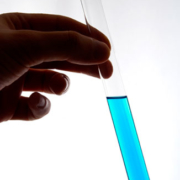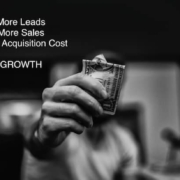Differences Between Sales Funnel and Full-Funnel Conversion Optimization
Sales funnel or full funnel conversion optimization? Which should you use and when? It all depends on what you want to understand.
Full funnel conversion optimization – or the Conversion Sciences Profit Funnel™ – provides the analysis and insights needed to help positively impact your business bottom line. Analyzing a sales funnel helps improve those issues found in a specific buying process.
There is nothing wrong about analyzing a sales funnel conversion rate or a sales funnel model for a specific segment of a customer journey. But your online business will definitively benefit from performing a Profit Funnel™ or full-funnel conversion optimization as well.
A highly experienced team of conversion experts can leverage both models when optimizing, instead of narrowing the view and hurting profits. An inexperienced conversion consultant will only see a siloed series of sales funnels, evaluate them independently and make decisions based on their own unique ROAS instead of their interactions.
Deliver double-digit sales growth every year, year after year. Increase revenues and profit. And shorten your sales cycle with our ecommerce and lead generation solutions.
Let’s review the key differences between sales funnel and full funnel conversion optimization or Profit Funnel™. We’ll begin with a great example of both models, a definition of a full marketing funnel. Finally, we’ll cover their differences in scope and the metrics used by each funnel.
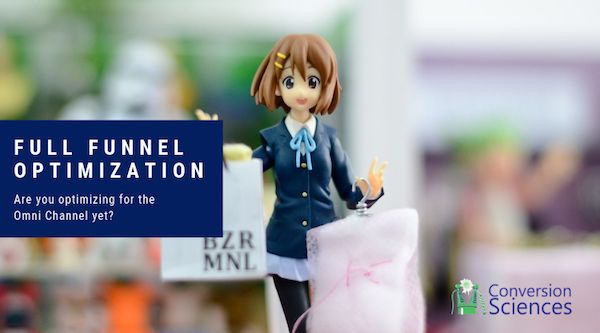
Happy customers means returning customers. The starting point for full funnel conversion optimization is the customer blueprint and guess whose CRO audit services include a map of the customer journey for your online shop?
Example of Sales Funnel vs Full Funnel Conversion Optimization
Imagine an addiction treatment center that offers both low-cost at-home testing kits and treatment programs. Their at-home drug testing kit sells for $10, and it costs $5 to manufacture and ship. Their treatment programs start at $15,000.
They have an effective social media presence, paid campaigns to engage and attract their target market. And they also provide valuable resources for people with addiction problems and for their loved on their website. These range from informational articles to online quizzes to help find out whether or not one is suffering from an addiction and what is the best course of action.
Ok. Time to tackle sales funnel optimization. If they analyze their PPC sales funnel they will realize that it is costing them $20 in ad spend to convert each home testing kit sale. This added to the manufacturing and shipping costs may lead them to determine that this $10 sale is costing the company $25. But they are not looking at their profit margins, they are simply calculating Return on Ad Spend or ROAS.
Thus, they may decide to turn off the ad spend and stop this failing campaign because they “lose” $15 per sale. Or they may attempt to improve a Google Ads campaign that is already performing quite well.
But what if this addiction treatment center looks at the full-marketing funnel or Profit Funnel™ instead?
They would find that 20% of their customers have repeated their kit purchase every 3 months.
By the same token, they have not estimated the impact that their content development and social media efforts have on those conversions. And they were attributing the sale to the last touch-point.
As the buyer journey is not limited to a single channel, analyzing a single sales funnel could narrow your business focus and marketing assessment scope.
Moreover, this treatment center finds that 2% of the people who purchase their $10 test later sends a loved one to their center for a $15k treatment program. Those $20 in ad spend for each testing kit sale got the family to notice their services and inquire about their drug-rehab program. Therefore, for every 100 tests they sell, an average of 2 patients will join their treatment program generating a minimum of $30,000 in revenue.
Before I became the CMO, I was more focused on how we were spending our marketing budget than on how marketing could help drive long-term business objectives.But thinking like this holds businesses back. Marketing should be valued for its long-term potential, rather than its short-term efficiencies.
-Monty Sharma, CEO and CMO, Jenny Craig
So, What is Full Funnel Conversion Optimization or Profit Funnel™ Optimization?
As we have noticed, a full funnel evaluates the 360 degree customer journey with a company or brand. Its goal is not only to acquire a customer but also to understand, nurture and improve their relationship and experience with the brand.
It focuses on not only pre but post-transaction because it takes into account how this will affect the probability of increased number of subscription renewals or sales, lower customer rotation, lower customer acquisition costs, and increased profit margins.
As we can clearly see, even though it’s called a funnel, this model looks more like an infinite loop with many potential touch-points throughout the buyers journey, over time and across a multitude of devices and online/offline experiences.
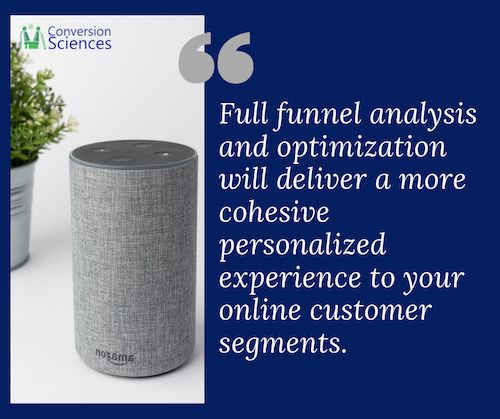
Have you even thought of people interacting with your site or buying from you via Alexa? Photo: Grant Ritchie via Unsplash.
1. Sales Funnel vs Profit Funnel™ or Full Funnel Optimization: Differences in Scope
One of the main differences between sales funnel and a full funnel conversion optimization is its scope. The oftentimes narrow span of a sales funnel is overshadowed by the number of elements or touch-points that a Profit Funnel™ considers.
Let’s check them out.
Single Path vs Infinite Loop: Are you optimizing for Omni channel yet?
The most evident difference between the sales and the Profit Funnel™ models lies in their reach. Highly restricted to a specific conversion path for the sales funnel versus a very broad view of the customer journey for the latter.
While most sales funnels are focused on a single transaction (such as a lead, sale or subscription) the full funnel or Profit Funnel™ acknowledges the entire lifetime of a potential customer or client. Its purpose is to allow us to take a step back and look at the entire customer journey or full marketing funnel and help optimize by what is most profitable without discarding the customer experience.
One Decision Maker vs Multiple Stakeholders
Have you been optimizing for a single decision-maker? Maybe you were leaving some marketing personas out of the equation. The higher the ticket price, especially for B2Bs, the higher the likelihood of having more than a single decision-maker involved in the purchasing process. Most companies will include different stakeholders’ input through the funnel and each one of them may further or delay that coveted B2B sale.
Sales funnel conversion optimization targets one person. Profit funnels recognize there is often more than one decision-maker.
Conversion Sciences Profit Funnel™ recognizes and accounts for this fact. Trying to optimize a single funnel to convert this lead is short-sighted, when understanding the 360 degree customer journey and optimizing for it, will significantly increase conversions and boost profit margins.
Single Device vs Cross-Device
We often find – when auditing a client’s conversion efforts – that their sales funnels don’t include mobile customers. Addressing this gap via mobile conversion optimization efforts has increased their profits manyfold.
The Profit Funnel™ recognizes the value of determining which of those platforms holds the highest potential for each particular conversion and finding a way to best optimize each path.
Sales funnels often focus on increasing conversions on a certain page on either mobile, tablet, or desktop. Thus, leaving out the reality that customers will interact with your brand, product or service in multiple ways and through as many devices as exist.
Have you even thought of people interacting with your site or buying from you via Alexa?
Full Funnel Conversion Optimization Enables a More Personalized Online Experience
The data-driven strategy of optimizing the full marketing funnel helps you identify consumer segments. Behavioral information can be collected in-store, online, and post-visit. The insights derived from this analysis helps you craft and deliver online personalized experiences to boost conversions and increase their contribution to your bottom line. All the while deriving insights to improving your marketing strategy.
“You are engaging with the consumer on an intimate level — they are telling you what products are interesting. That customer data is one of the most important things to grow your brand.” – Kate Kibler, Timberland’s VP of direct-to-consumer.
For high-traffic sites, Conversion Sciences offers the latest martech stacks – ML and AI-powered – via the Conversion Catalyst AI™. Our Conversion Catalyst AI™ builds a predictive model that identifies which visitors are ready to buy, and delivers the perfect experience so that they are more likely to buy from you. So you can deliver the most optimized experience be it on your website, on wearable devices, voice search, augmented-reality or any of the myriad of experiences the IoT brings us.
Full funnel analysis and optimization will deliver a more cohesive personalized experience to your online customer segments.
2. Sales Funnel vs Full Funnel Conversion Optimization Metrics
It’s hard to take a look at your full marketing funnel and try to gauge how well it’s working besides ROI and profit margins. But following those metrics without fully understanding which effort or efforts made the difference, is no way to run a business either. But lucky you. Full funnel is optimized with your bottom line in mind and a bespoke full funnel attribution will help you identify what’s helping and what’s hindering your conversions.
Therefore, the difference between sales funnel and full funnel conversion optimization is that you will end up concentrating your marketing spend on those efforts who bring in profitable returns. Much better than looking at a measly conversion rate. right? ;)
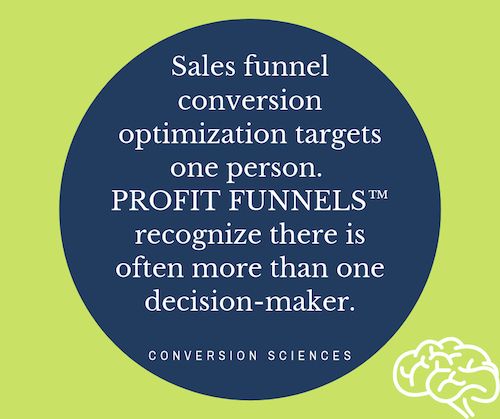
Sales funnel conversion optimization targets one person while Profit funnels recognize there is often more than one decision-maker.
ROAS vs ROI
Are you narrowing your business focus down to sales funnels and conversion rates? Are you making decisions that affect your whole business by a simple ROAS? Or are you leveraging a 360 degree customer blueprint to improve your company’s profit margins?
Do you need your customer journey mapped? Check out Conversion Sciences conversion rate optimization audit services.
In the addiction treatment center example, when the sales funnel was not profitable (its ROAS was negative), they could have shut down the ad campaign. But when they looked at the full funnel (in-patient treatment registrations), the ad investment was profitable and it justified the initial losses in the funnel. It had a positive ROI.
Thus, by using both metrics, you can isolate those efforts whose ROAS may be positive but not their ROI, which takes into consideration not a single digitally advertised campaign but how each contributes to the business profit margins. And you can spare from killing efforts with negative ROAS because, in the end, their revenue-generating power is much larger than the one calculated from the revenue from ad campaign/cost of ad campaign.
By doing so, you change the focus to driving business performance, not just advertising performance.
Single Attribution vs Custom Attribution
Going back to the addiction treatment center example. There are things they do that contribute to their bottom line – such as informational blog posts, quizzes, etc. But their attribution model assigned the conversion value to a single Google Ads campaign.
People have several contacts with a brand before they even consider converting on that landing page, clicking on that PPC ad or that Instagram shoppable image. Which means that any and all contributions along the 360 degree funnel, or full funnel or Profit Funnel™ must be taken into account and their value toward each of the conversions (testing kit purchase, treatment) attributed properly to measure its impact on revenues and on profit margins.
While a single touch attribution model is a fast and simple way to allocate credit to a campaign, full funnel must use a bespoke or custom attribution model to understand what is working and what is not.
It’s common yet dangerous and naive to make assumptions about which touchpoint to attribute credit for a conversion. Oftentimes these assumptions are created from unrecognized personal bias and proven false through data analysis. This is one of the biggest reasons that analyzing all metrics is vital to a company’s long-term success.
- 7 Simple & Effective Ways to Improve Your Email Open Rates - February 23, 2021
- The 3 Most Effective Marketing Strategies For Ecommerce Businesses - December 26, 2020
- Google Ads not Converting? Try These 4 Optimization Tricks - August 6, 2020

